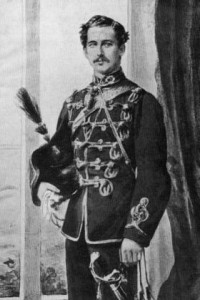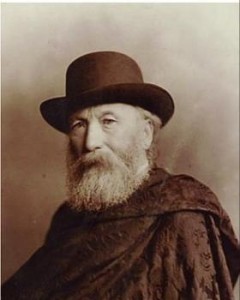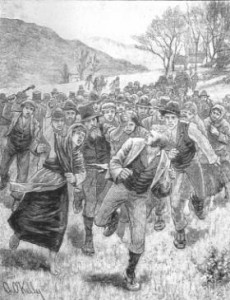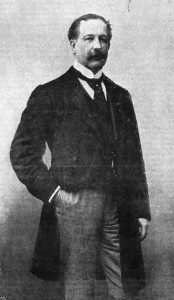The Captain and the Fenians: William Henry O’Shea and the IRB
Published in 18th–19th - Century History, Features, General, Irish Republican Brotherhood / Fenians, Issue 5 (Sep/Oct 2009), Volume 17
William Henry O’Shea as a young captain in the 18th Hussars. (Multitext, UCC)
When Charles Stewart Parnell’s coffin was drawn through the streets of Dublin on Sunday 11 October 1891, the carriages immediately following the hearse were occupied, appropriately, by members of his family. Four carriages back, however, was one carrying a number of prominent Fenians, most notably John O’Leary and James Stephens. Accompanying the two legendary IRB leaders was the less celebrated Patrick Neville Fitzgerald. Fitzgerald was, nonetheless, a very senior and influential Munster Fenian. One of his responsibilities was monitoring the Fenian arms dumps in the south and south-west of the country. The open presence of O’Leary and Stephens at such an emblematic event was connected with Parnell’s opportunistic and belated rediscovery of his ‘advanced’ roots as he struggled for his political life in the wake of the post-divorce Irish Party split. As the cortège moved toward Glasnevin, Fitzgerald might well, given the circumstances of the day, have thought it wise not to mention his own connection with the man who had precipitated that divorce: William Henry O’Shea, husband of Katharine.
Inveterate prison visitor
O’Shea’s flirtation with a breed of extreme nationalists whose projects were utterly at variance with his own derived partly from the timeless adage that ‘the enemy of my enemy is my friend’, partly from his relentless clientelism and largely from his desperate search for political allies as the constituency of Clare slipped inexorably from his grasp. O’Shea’s brand of half-hearted nationalism had no appeal for doctrinaire republicans. But his regular opposition to the dictates of the Irish Party leader allowed him a foot in the IRB door. Given the localised nature of much of the Fenianism of the 1880s, O’Shea’s pursuit of electoral popularity via a clientelism almost unique among Irish politicians of the time also rebounded to the benefit of extreme republicans. O’Shea, anxious to gain credit with his disillusioned electorate, became an inveterate prison visitor in 1882, when the impact of British coercion legislation led to a number of suspected agrarian agitators being rounded up and jailed without trial. Many of those prisoners were either members of or associated with the Irish Republican Brotherhood. Despite his status as a singularly uncommitted nationalist MP, it was a relationship O’Shea learned to cultivate for his own purposes.
Among the Clare constituents whom O’Shea either visited in prison or placed questions on their behalf to the chief secretary in the House of Commons were Patrick Frost from Tulla and Martin Crotty, Patrick Slattery and the Clune brothers(Bryan and Matthew) from Scariff. Frost was one of eighteen men arrested on treason-felony charges and later re-arrested under the terms of the Protection of Persons and Property Act. Their arrest had been requested by a special resident magistrate, Clifford Lloyd, on the basis that ‘all eighteen are notorious rebels in the locality’. Crotty had been arrested at the same time as Frost. O’Shea had either visited him in prison or made representations on his behalf on three occasions. His police file includes a note from Lloyd seeking his incarceration on the basis that it was ‘absolutely necessary to prevent further bloodshed in this district’.
‘Murder in Co. Clare if I am opposed’

James Stephens—the prominent Fenian attended Parnell’s funeral in October 1891 with John O’Leary and the less-celebrated Fenian Patrick Neville Fitzgerald, who had links with the man Parnell had cuckolded, Captain O’Shea.
As his welcome in Clare began to wear out, O’Shea’s association with ‘the real boys’, as he called them (the ordinary members of the Irish Parliamentary Party he described contemptuously as ‘the boys’), became more public and overt. In 1883 he had fulminated in the Commons against the arrest of a number of his constituents from the village of Crusheen who were accused of Fenian activities. The so-called ‘Crusheen conspiracy’ had been laid bare by dubious informer testimony, but the evidence had failed to stack up in court and the authorities released ‘conspirators’ with great reluctance. RIC files identified many of the accused as Fenians or members of agrarian secret societies.
O’Shea claimed his reward for services rendered in 1884 at a public meeting in Crusheen. At the time he was in danger of being ‘de-selected’ as a nationalist candidate for the next general election. One of the few groups prepared to stand by him was the local Crusheen Fenian organisation. At least three members of the platform party on Sunday 19 October at a rally in Crusheen addressed by O’Shea were, according to police files, probable Fenians. Two others had been ‘lifted’ after the passage of the Coercion Acts of 1882. Revealingly, the platform lacked a single member of the clergy. Their absence was most likely associated with the strong Fenian presence. After the meeting O’Shea wrote to his wife that ‘the Fenians have now shown such an extraordinary support that, as they themselves say, there will be murder in Co. Clare if I am opposed’. It was wishful thinking on his part. When the election was called in 1885, it was made clear to him that, as an unpledged MP with a record of voting against Parnell’s wishes, he would not be selected to run as a nationalist.
One of the Clare newspapers that consistently supported O’Shea, the Advertiser, offers an unintended hint as to one possible reason for the aforementioned P. N. Fitzgerald’s surprising support of O’Shea: ‘His constituents have reason to be much pleased with the exertions of Capt. O’Shea MP who has effected a reduction in the Police Force of this county . . .’, drawing attention to the consequent reduced taxation of the county. But a reduction in policing activity, which had assumed a quasi-military aspect, also meant that Fitzgerald’s arms dumps were somewhat more secure.
Switches to Galway
Whatever the reason for his support, Fitzgerald appears to have been prepared to countenance an O’Shea candidacy in Galway long before Parnell was obliged to foist the husband of his mistress on the constituency in February 1886. In a letter written to Katharine O’Shea in December 1885, her husband included an enclosure from a man he referred to as a ‘Fenian Chief’. He informed his wife that ‘the real boys want Galway fought’. (The constituency faced a by-election as its MP, T. P. O’Connor, had also been elected for Liverpool, Scotland, in the 1885 general election and opted to sit for the latter.) The enclosure informed O’Shea that the ‘Fenian Chief’ had discussed Galway with Fitzgerald and that ‘P[atrick] N[eville] F[itzgerald] is willing to do all he can, but wishes to have the movement commence here in Clare . . .’. The mysterious Fenian overlord added that ‘if Bryan Clune stands for Galway it will be pretty hard to beat him, and if at the last moment he yields to the request of his Clare friends and retires in favour of any person, that person will be rather safe’. The plan, to have Clune withdraw in favour of O’Shea, seems to have had the imprimatur of Fitzgerald, a man with decision-making power in the Munster IRB. The scheme, however, came to nothing and O’Shea was reduced to blackmailing Parnell into supporting his (successful) candidacy instead.
O’Shea and the Commission on Parnellism and Crime

‘Agitation: Attack on a Process Server’ by Aloysious O’Kelly. O’Shea became an inveterate prison visitor in 1882 when the impact of British coercion legislation led to a number of suspected agrarian agitators being rounded up and jailed without trial. (Illustrated London News, 21 May 1881)
Much of the investigation of O’Shea’s links to the netherworld of agents provocateurs and government informants was conducted by Michael Davitt at the time of the Commission on Parnellism and Crime. Parnell’s attempt to discredit the Times and the notorious ‘facsimile’ letter (forged by Richard Pigott) proceeded from the first premiss that the letter implicating him in support for the Phoenix Park murders was actually the work of O’Shea. Davitt’s account of his investigation, contained in his ‘Notes by an Amateur Detective’ (available for scrutiny in the archives of Trinity College, Dublin), suggests that he agreed with Parnell and that he was setting out to connect O’Shea to Pigott. While he never established this link beyond reasonable doubt, he did manage to uncover O’Shea’s contacts with a host of unsavoury characters. With some he dealt directly. Others were contacted through Mulqueeny.
It was only when O’Shea took the stand early in the Times Commission proceedings that the questions of Parnell’s counsel, Sir Charles Russell, alerted him to the fact that his intrigues had been uncovered. The very first reference to Pigott at the Times Commission came about when O’Shea was asked whether he knew the Dublin journalist. He admitted to knowing of him. The mention of Pigott passed unnoticed by reporters covering the proceedings. O’Shea was then questioned, without explanation or apparent rationale, about a number of his Parisian contacts and about Mulqueeny. The clear intention on the part of Parnell’s defence team was to use Davitt’s intelligence information to rattle cages on the Times side. The edgy captain was probably fortunate that a lack of preparation on the part of Russell (O’Shea was introduced as a witness out of sequence and virtually without notice) meant that there was no elaboration of the many enigmatic questions posed to the witness in cross-examination. Nevertheless, the fullness of Russell’s information must have served as a warning to O’Shea, whose anti-Parnellite activities took an entirely different direction thereafter.
Unprincipled politics
O’Shea’s association with the republican movement, however limited, is an indication of his unprincipled and highly personalised approach to politics. Where his political survival was at stake, he was prepared to ally himself to extremists with whose ideology he was completely at odds. His reluctance to support the Irish Party in many crucial votes in the House of Commons placed him firmly in the ‘Whig’ camp in the 1880–5 parliament. He had nothing to offer the Fenian movement other than the traction his Whiggishness had created with influential elements within the Liberal administration. His services in that area came with a price tag attached. After his political career ended he was also prepared to make use of their services in the war he was waging against Parnell. This at least had some malign logic to it.
There is more than a hint, where O’Shea’s IRB conspiracies are concerned, of boys playing at revolution (in the case of the Fenians) and a love of intrigue (in the case of O’Shea). Both parties had an exaggerated sense of their own significance. Other than Fitzgerald, we have no idea whether the Fenians with whom O’Shea associated were of any real organisational consequence. That they would be prepared to engage, even in a coalition of expediency, with a Whiggish politician lacking any meaningful powerbase suggests not. In his analysis of the IRB membership, The Fenians in context: Irish politics and society, 1848–1882, R. V. Comerford has pointed to the social and recreational element of involvement with the Brotherhood. He sees it as a form of fraternisation and social activity. Were it not for the sustained and practical nature of the alliance with O’Shea, one would be tempted to the conclusion that Clare Fenians were indulging in some sporting activities of their own in their association with the captain. It was certainly an odd form of fraternisation.
Unlike the funeral of the man whose political career he was instrumental in destroying, there was no Fenian presence at the obsequies of William Henry O’Shea. He was buried in Hove on the south coast of England in 1905. The ceremony was attended by two mourners, his son-in-law and his son. HI
Myles Dungan is a broadcaster and author. His latest book Conspiracy: Irish political trials under the Union has just been published by the Royal Irish Academy and RTÉ.

Captain O’Shea c. 1880—his association with the republican movement, however limited, is an indication of his unprincipled and highly personalised approach to politics. (Multitext, UCC)
Further reading:
M. Davitt, The fall of feudalism in Ireland (London and New York, 1904).
M. Dungan, The Captain and the King: William O’Shea, Parnell and late Victorian Ireland (Dublin, 2009).
O. McGee, The IRB (Dublin, 2005).
















